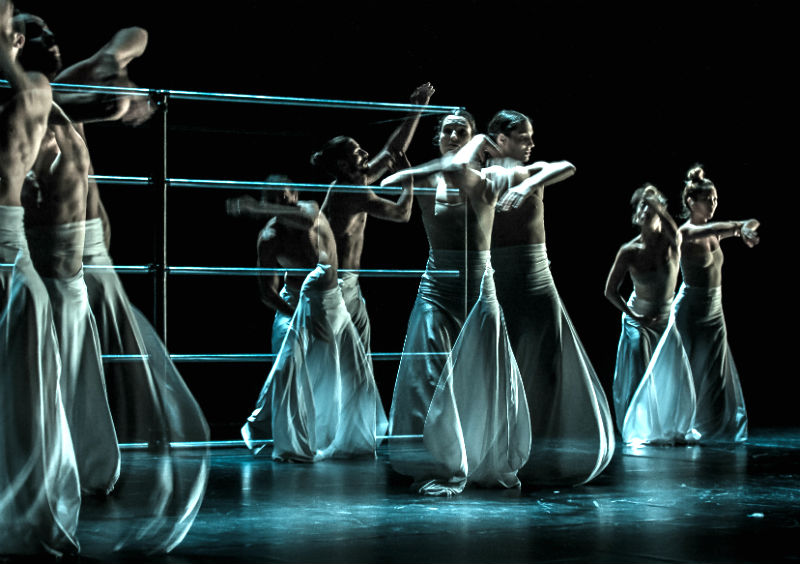Company Wang Ramirez keeps on pushing over the "Borderline"

“When we put ourselves in positions of risk, interesting things happen,” says choreographer Honji Wang. She is talking to me on the phone from Minneapolis about the upcoming performances of Company Wang Ramirez -- the group of dancers she leads with partner Sébastien Ramirez -- at Ann Arbor’s Power Center, March 9-10, as part of UMS's season. Our conversation is shot through with Wang’s references to what is interesting, and it reveals an ongoing passion for illuminating the unexpected and the provocative through dance.
Her comment on risk refers to Company Wang Ramirez’s penchant for “collaborations with other worlds.” Grounded in hip-hop, martial arts, and ballet, she and Ramirez have nonetheless made dances with New York City Ballet principal dancer Sara Mearns, with avant-garde flamenco dancer Rocío Molina, and with Madonna on her Rebel Heart tour. “Even though they are different styles of movement,” notes Wang, “there’s so much that’s the same.” The risk, and the interest, in these collaborations lies in “looking for the not-similarities,” in finding the places where the different dance styles challenge each other and push the work into unfamiliar territory.
The dance they will show at the Power Center, Borderline (2013), involves a different sort of collaboration -- with riggers, people providing (usually offstage) counterweight to the dancers who are attached to cables on pulleys. The rigging allows the dancers to “experiment with levitation” in Borderline. Wang observes that it imposes limits on the dancing even as it breaks limits, allowing dancers to escape the floor.
Choreographers have used assorted mechanical devices to alter a dancer’s relationship to gravity before. Romantic ballets of the 1840s used a type of rigging to enable ethereal sylphs to fly, and contemporary dance-makers like Jo Kreiter in San Francisco and Fabrice Guillot of France’s Compagnie Retouramont employ harnesses and other apparatus to explore “vertical dance” in urban settings, to name just a few. Borderline, however, incorporates its machinery differently. Here, flight is not the centerpiece of the choreography; instead, gravity-defying moments are interwoven into the dance poetically, supporting themes of freedom and constraint, and coloring relationships among the dancers. Wang notes that levitation “can be explosive, but the subtler it gets, the more interesting it gets.” In some danced passages, weightlessness plays only a small role or none at all so that when a dancer does mock gravity, it takes you off-guard. It seems magical, or preternatural -- like the physical wonder of CGI or a good graphic novel transposed onto dance.
Levitation is tricky. When dancers are attached to a rigger, issues of security and logistics arise, and these add to an already complicated mix. The dancers in Borderline are freelance; that is, unlike members of a ballet company who have a steady and ongoing rehearsal process, they come together only for rehearsals and performances of this particular piece. These limited rehearsals are necessarily intense -- not only incorporating notes and changes from recent performances and accounting for the challenges of the rigging but also continuing to grow the piece. “It is still evolving, constantly evolving,” Wang says.
This evolution is a fairly democratic one. “Everyone in the piece is a contributor,” she says. “Our base language that we all share is hip-hop, but we go beyond it.” Again, Wang's interest lies in the “not-similarities,” casting into relief the particularities that each cast member of Borderline brings to the process. In a way, this honors the hip-hop tradition that prizes the accomplishments of the individual within the cipher, or circle of dancers.
The dancers’ individuality plays into the themes of Borderline as well. Wang explains that during the creative process, “We don’t know what we’re going to develop, but all these things are happening -- personal, social, individual. They all influence the work, maybe subconsciously.” This particular piece was affected by the fact that most of the dancers have first-hand experience with immigration, or with growing up in cultures separate from their families’ origins and traditions: “Each of the dancers has a strong background culturally, where they come from,” Wang says.
The dancers’ conflicts around tradition become the stuff of Borderline, but larger political issues are there as well. Voice-over soundtracks for the piece include a teacher outside Paris complaining about police violence to her students, as well Ramirez’s father discussing his escape from Franco’s dictatorship in Spain. While a borderline is both a personal and a social metaphor in this dance, Wang clarifies, “We’re not offering opinions. We just share these frictions and social things that make us who we are.”
And this, along with the work’s many other layers, makes for very interesting dancing.
From 1993-2004, Veronica Dittman Stanich danced in New York and co-produced The Industrial Valley Celebrity Hour in Brooklyn. Now, Ph.D. in hand, she writes about dance and other important matters.
Company Wang Ramirez performs at the Power Center, 121 Fletcher St., Ann Arbor, on March 9-10, 8 pm. Visit ums.org for tickets and more information.



































Comments
Interesting!
Interesting!